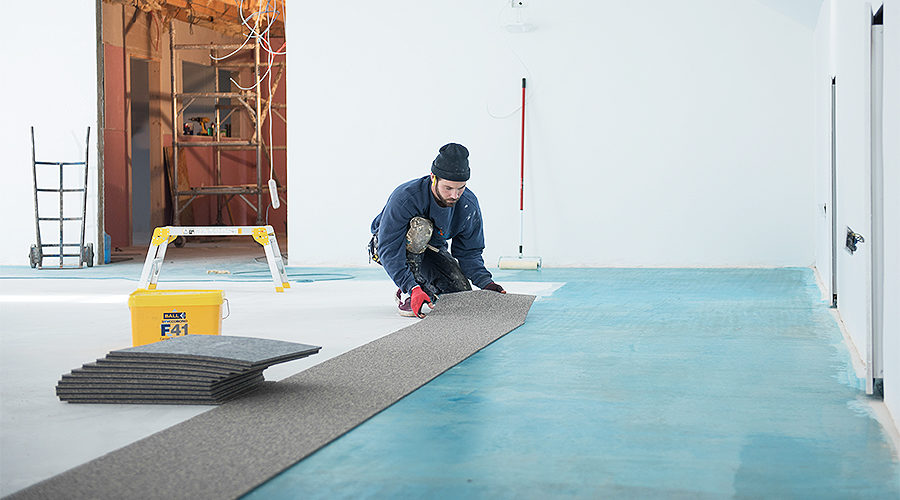In many cases, the longevity of flooring installations is as important a consideration as the aesthetic appearance, with the need to maximise time between refurbishments and value for money particular concerns for public sector projects. Fortunately, this can be achieved by following a few simple steps, as well as using optimum products at each stage, as Neil Sanders, Technical Director at leading manufacturer of subfloor preparation products, F. Ball and Co., explains.
F Ball
Ensuring a long-lasting, visually-attractive flooring finish involves following best practice in subfloor preparation and choosing a suitable adhesive based on chosen floorcoverings and environmental conditions. Making sure the subfloor is in a suitable condition before work begins, applying a smoothing compound to ensure a smooth base for the receipt of floorcoverings and remembering to prime beforehand are important processes for avoiding an unsightly finish or even complete floor failure.
Subfloor preparation
The first step in any flooring installation is to make sure the subfloor is suitably sound and smooth. If the subfloor is a newly-installed screed, contractors will need to ensure that any laitance, the crust of cement and fine aggregates that forms on the surface of the screed as it dries, is ground off.
If the project is part of a refurbishment, the condition of the subfloor should be assessed once old floorcoverings have been removed. Cracked or damaged subfloors will require extra preparations, with cracks as deep as 50mm capable of being filled with a floor repair compound.
Subfloors contaminated with oil, grease or other chemicals will necessitate mechanical preparation, extraction or encapsulation of the contaminants, and heavily-contaminated floors may require complete removal. Old adhesive residues will also need to be removed mechanically unless a smoothing compound that is suitable for use over old adhesive residues is to be used.
Dealing with damp
Contractors need to be particularly aware of the problems posed by excess subfloor moisture in the base. Whether the result of rising damp or residual construction moisture, unmanaged subfloor moisture can attack adhesives and floorcoverings, possibly causing complete floor failure.
For these reasons, F. Ball recommends that a moisture test is conducted to determine subfloor relative humidity (RH) levels as part of any flooring installation. Where a moisture test indicates that subfloor RH levels are above 75% (65% if wood floorcoverings will be installed), a moisture management solution will be required to suppress excess subfloor moisture levels and prevent floor failure.
The application of a waterproof surface membrane is the typical solution for effectively controlling damp. The best-performing epoxy waterproof surface membranes will isolate excess subfloor moisture where RH values are up to 98%, with a single-coat application, which will fully cure in as little as three hours.
Smoothing compound selection
Once satisfied that the subfloor is dry, or an appropriate moisture management solution is in place, a suitable floor-smoothing compound should be applied to ensure a perfectly-smooth base for the receipt of floorcoverings.
General-purpose smoothing compounds are available for many situations, as well as products with a wide variety of specialist applications. When contractors are working to tight timescales, the fastest-drying smoothing compounds on the market will be walk-on hard from just 30 minutes and ready to receive floorcoverings in as little as 45 minutes after application. Flexible smoothing compounds that are fibre-reinforced are recommended over flexible subfloors, such as steel and plywood, to cope with the natural movement in these subfloors. Smoothing compounds with high compressive strength should be used where floors will be subject to heavy loads or high foot traffic, while calcium sulphate-based smoothing compounds provide optimum compatibility with calcium sulphate screeds.
In most cases, it will be essential to prime a surface before applying a smoothing compound. This promotes the optimum performance characteristics of the smoothing compound and, when used over absorbent subfloors, such as concrete, prevents moisture being drawn from the smoothing compound, which will lead to a reduction in the working time. For time-saving purposes, smoothing compounds are available that can be applied directly over old adhesive residues without the need to prime beforehand.
Adhesive choice
Once the smoothing compound has cured, contractors can proceed to install floorcoverings using an appropriate adhesive.
Adhesive selection should be based on the specifics of an individual flooring installation, including the properties required for ease of installation and the conditions to which the adhesive will be exposed to optimise the appearance and longevity of flooring installations.
Vinyl floorcoverings
While wet-lay adhesives are suitable for installing vinyl sheet, where an immediate bond is not required, the instant grab and long open time of pressure-sensitive adhesives means that they are often the best choice for installing vinyl tiles or planks.
Hybrid adhesives technology has enabled the development of pressure-sensitive adhesives with a range of additional features, including temperature tolerance and moisture resistance.
Moisture resistance
When installing flooring in an area subject to high levels of humidity or surface water, an adhesive with water-resistant properties is essential. Epoxy- or polyurethane-based adhesives are highly effective at making areas impermeable to water, so they are also suitable for installing vinyl and rubber floorcoverings outdoors where surface water may collect. Advancements in technology have enabled the development of one-part, moisture-curing alternatives for internal and external heavy-duty applications.
Textile floorcoverings
Specialist adhesives for textile floorcoverings are available that will develop the high-bond strength required to enable carpet installations to withstand high levels of wear when installed over large areas that will be subject to heavy use.
Carpet tile tackifiers ensure that carpet tiles are held firmly in place when subject to lateral movements, including everyday foot traffic and equipment being wheeled around, while allowing them to be easily lifted vertically if they need to be replaced at a later date if they become damaged, worn or stained.
Compatibility check
Finally, it is highly recommended that contractors check the compatibility of particular floorcoverings and adhesives. For this purpose, F. Ball produces its Recommended Adhesives Guide (RAG), which lists adhesives recommended for use with over 6000 floorcoverings produced by over 200 manufacturers.










